XFX’s Radeon HD 7970 Black Edition Double Dissipation: The First Semi-Custom 7970
by Ryan Smith on January 9, 2012 6:00 AM ESTThe Test, Power, Temp, & Noise
| CPU: | Intel Core i7-3960X @ 4.3GHz |
| Motherboard: | EVGA X79 SLI |
| Chipset Drivers: | Intel 9.2.3.1022 |
| Power Supply: | Antec True Power Quattro 1200 |
| Hard Disk: | Samsung 470 (240GB) |
| Memory: | G.Skill Ripjaws DDR3-1867 4 x 4GB (8-10-9-26) |
| Video Cards: |
XFX Radeon HD 7970 Black Edition Double Diss. AMD Radeon HD 7970 AMD Radeon HD 6990 AMD Radeon HD 6970 AMD Radeon HD 6950 AMD Radeon HD 5870 AMD Radeon HD 5850 AMD Radeon HD 4870 NVIDIA GeForce GTX 590 NVIDIA GeForce GTX 580 NVIDIA GeForce GTX 570 NVIDIA GeForce GTX 470 NVIDIA GeForce GTX 285 |
| Video Drivers: |
NVIDIA ForceWare 290.36 Beta AMD Catalyst Beta 8.921.2-111215a |
| OS: | Windows 7 Ultimate 64-bit |
We’ll start things in reverse today by first looking at the power, temperature, & noise characteristics of the 7970 BEDD. The custom cooler is the single biggest differentiating factor for the BEDD, followed by its factory overclock.
| Radeon HD 7900 Series Voltages | ||||
| Ref 7970 Load | Ref 7970 Idle | XFX 7970 Black Edition DD | ||
| 1.17v | 0.85v | 1.17v | ||
As we noted in our introduction, the BEDD ships at the same voltage as the reference 7970: 1.17v. Since XFX is using the AMD PCB too, the power characteristics are virtually identical, save for the overclock and the power draw of the two fans.
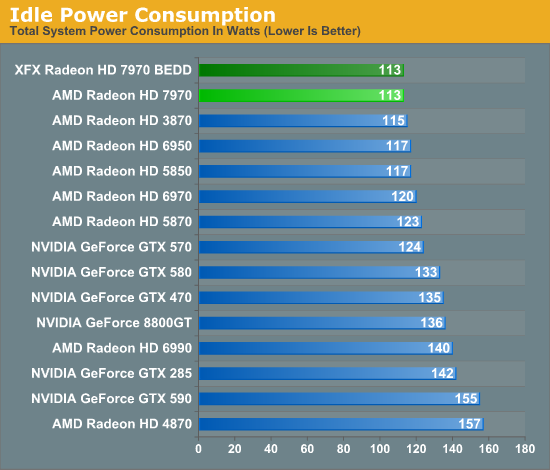
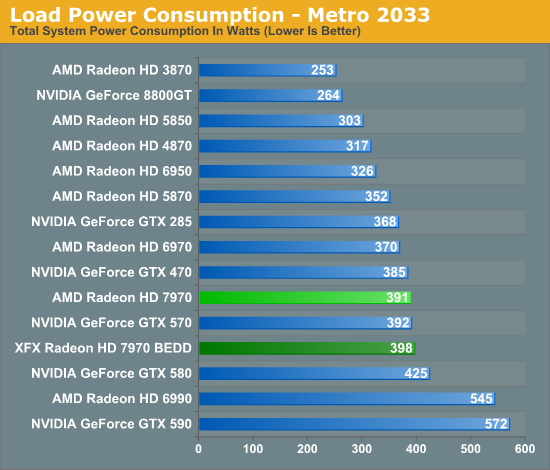
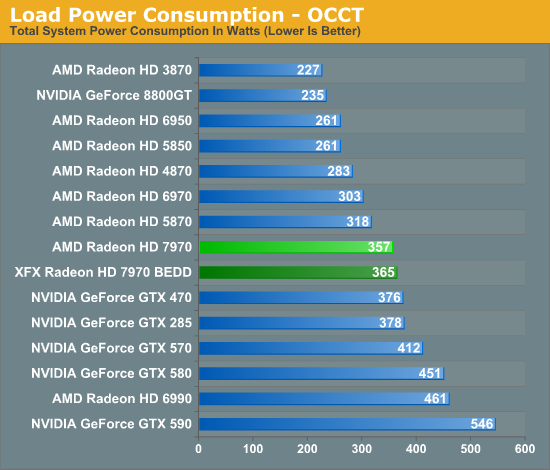
Even with two fans the idle power consumption of the BEDD is identical to the reference 7970. Meanwhile under load we see that the power consumption for the BEDD creeps up slightly compared to the reference 7970. With Metro 2033 we see system power consumption peak at 398W, 7W over the reference card, meanwhile under OCCT system power consumption peaks at 365W, 8W over the reference card.
It’s worth noting that as XFX has not touched the PowerTune limits for the BEDD, it’s capped at the same 250W limit as the reference 7970 by default. So far we haven’t seen any proof that the BEDD is being throttled at this level under any of our games or compute benchmarks, however we can’t completely rule this out as we still don’t have any tools that can read the real clockspeed of the 7970 when PowerTune throttling is active. Whenever an overclock is involved there’s always a risk of hitting that PowerTune limit before a card can fully stretch its legs, hence the need to be concerned about PowerTune if it hasn’t already been adjusted. As for our power tests, the difference seems to largely boil down to the higher power consumption of XFX’s fans when they’re operating above idle.

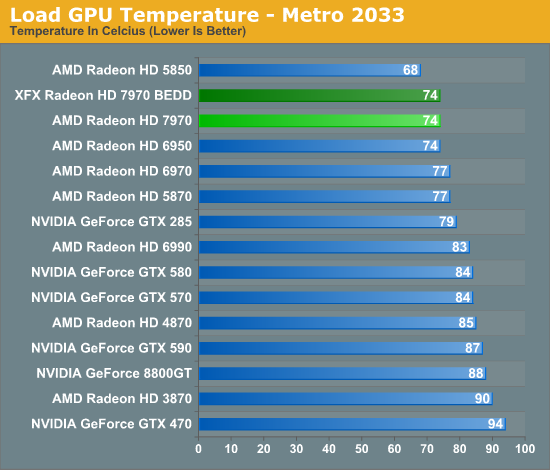
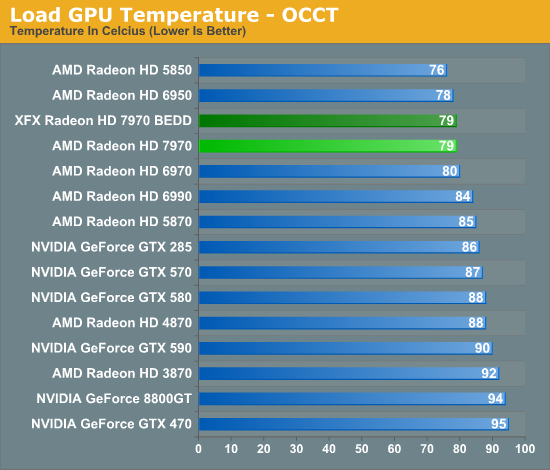
One of the key advantages of open air designs is that they do a better job of dissipating heat from the GPU, which is what we’re seeing here with the BEDD under idle. At 30C the BEDD is 4C cooler than the reference 7970, with all of that being a product of the Double Dissipation cooler.
However it’s interesting to note that temperatures under load end up being identical to the reference 7970. The BEDD is no cooler than the reference 7970 even with its radically different cooling apparatus. This is ultimately a result of the fact that the BEDD is a semi-custom card; not only is XFX using AMD’s PCB, but they’re using AMD’s aggressive fan profile. At any given temperature the BEDD’s fans ramp up to the same speed (as a percentage) as AMD’s fans, meaning that the BEDD’s fans won’t ramp up until the card hits the same temperatures that trigger a ramp-up on the reference design. As a result the BEDD is no cooler than the reference 7970, though with AMD’s aggressive cooling policy the reference 7970 would be tough to beat.
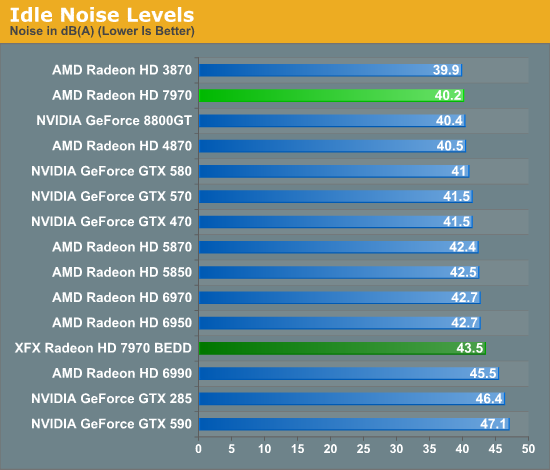
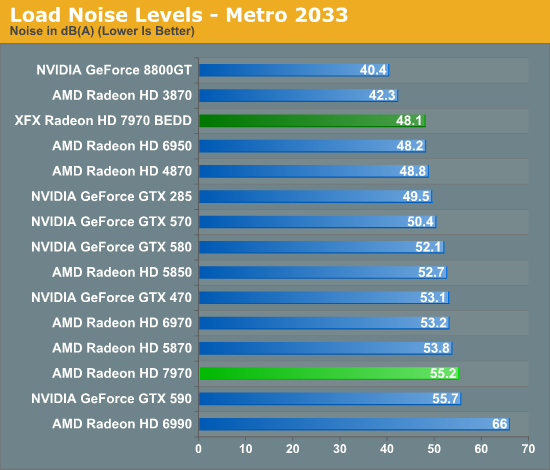
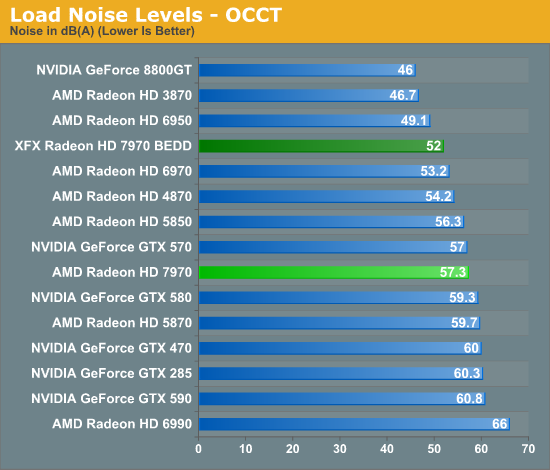
Finally taking a look at noise we can see the full impact of XFX’s replacement cooler. For XFX this is both good and bad. On the bad side, their Double Dissipation cooler can’t match the 7970 reference cooler when idling; 43.5dB isn’t particularly awful but it’s noticeable, particularly when compared to the reference 7970. Consequently the BEDD is definitely not a good candidate for a PC that needs to be near-silent at idle.
On the flip side under load we finally see XFX’s cooler choice pay off. AMD’s aggressive fan profile made the reference 7970 one of the loudest single-GPU cards in our lineup, but XFX’s Double Dissipation cooler fares significantly better here. At 48.1dB under Metro it’s not only quieter than the reference 7970 by a rather large 7dB, but it’s also quieter than every other modern high-end card in our lineup, effectively tying with the reference 6950. Even under our pathological OCCT test it only reaches 52dB, 5dB quieter than the reference 7970.
Ultimately where the BEDD was a poor candidate for noise under idle, it’s an excellent candidate for a quiet computer under load thanks to the open air nature of XFX’s Double Dissipation cooler, and certainly the launch card to get if you want a load-quiet 7970. Just don’t throw it directly up against another card in CrossFire, as these open air cards typically fare poorly without an open slot to work with.










93 Comments
View All Comments
radium69 - Monday, January 9, 2012 - link
Maybe it's me, but this looks VERY classy!Not gimmicky and plasticky but very tight and sexy!
I'm going to keep an eye out for this card. hope they stick more with the allumium design.
RubyX - Monday, January 9, 2012 - link
Couldn't you fix the idle noise issue by just changing the fan speed via software? Or is that not possible with this card for some reason?Ryan Smith - Monday, January 9, 2012 - link
The lowest fan speed with AMD's fan profile is 20%, which is where it already settles to at idle. It's not possible to go below 20% right now, hence 43dB really is as quiet as the DD cooler can get.dj christian - Tuesday, January 10, 2012 - link
Well i can go to 0% in MSI Afterburner. But the fan never stops no matter how low you put itRyan Smith - Tuesday, January 10, 2012 - link
Afterburner is just a frontend to Overdrive in this case. It can't take the fan any lower than Overdrive will allow, and that's 20%.james.jwb - Thursday, January 12, 2012 - link
what about speedfan?cactusdog - Monday, January 9, 2012 - link
I'm going to wait for a better quality non-reference cooler like the Asus DCUII, MSI Twin Frosr, Sapphire vapourX, Gigabyte Windforce.If you can hear the card at idle that is a disaster, especially when it costs $60 more
LB-ID - Monday, January 9, 2012 - link
I completely agree. Sapphire's VaporX cards have spoiled me, I won't settle for less as far as acoustic management is concerned.Artifex28 - Tuesday, January 10, 2012 - link
Got lucky year back or so and got a VaporX 5870 instead of my original 5850. Can´t complain. Excellent card!In my case it´s an external HDD fan that makes the most noise and this pulsating hum...
piroroadkill - Monday, January 9, 2012 - link
I agree that it is pathetic you can hear it at idle, especially given ATI's massive gains in the areas of idle power. Massive gains.I use a custom fan curve through MSI Afterburner on my Radeon 6950 Twin Frozr III, and it is simply inaudible at idle.